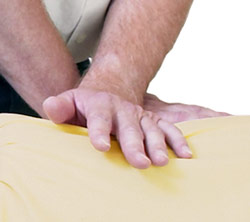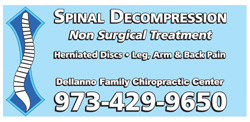Non-surgical Spinal Decompression
In order to understand how Non-surgical Spinal Decompression works, you must have an understanding of the a spinal anatomy, especially intervertebral discs. The following information is a brief introduction to the anatomy of the spine.
What Are Vertebral Discs and Why Do I Need Them?

In order to answer this question we have to take a quick look at the anatomy of the spine. The spine itself is made up of 24 bones that are connected and stacked on top of one another. There reason why they are 24 separate bones is to allow the spine the ability to twist and turn and bend in several different directions and give us some ability to move around. The only downside to having 24 different bones is that by themselves these bones are not very strong. If your spine did not have any ability to absorb the pressure of gravity, all of these bones would just get crushed on top of one another as soon as we jumped up and down. In order to allow our spines the ability to absorb shock, we need something to absorb all this pressure. This is where discs come into play.
Our spine has two primary sources of shock absorption. The first is the three normal curves that the vertebrae should be aligned in. These curves allow the vertebra to compress and expand on top of one other cause a “spring like” action to absorb shock. The second mechanism to absorb shock is the vertebral discs. Between each vertebra is a small pad that separates the large square like body of the vertebrae. This disc is made up of a watery gelatinous fluid surrounded by a hard cortex that is very smooth and helps connect each vertebra to one another.
These discs have two important jobs. The first job is to act as a lubricating pad and allow smooth movement of the vertebrae as they move on top of one another. The second job is to assist the curves in shock absorption when we run, jump, lift, as well as protect the vertebrae when we fall or suffer some form of trauma. The problem with the discs is that they are not invincible and are prone to injury by sudden trauma or degeneration over time due to prolonged pressure.
What Is a Disc Herniation?

There a several types of disc injuries that can occur. Two of the most common are the disc bulge and herniation. These injuries are sustained by sudden trauma to the spine that cause the jelly like interior of the disc to push out onto the hard outer cortex, or wall, of the disc causing the wall to either bulge out forming a pimple like protrusion or to actually rip the outer wall apart forcing the jelly like materially to push through. If either of these injuries are formed at the back of the disc, the protruding material will either press upon the a portion of the spinal cord or the nerve roots that exit the spine to travel out to different parts of the body.
When a disc is damaged your body will respond by causing inflammation in the surrounding area, causing localized sharp or “biting” pain at that area. If the inflammation gets large enough and the spinal cord or spinal nerve roots become pinched, this pain will “travel” or radiate down the pathway of the nerve. For example a herniation at the L4-L5 disc will travel into the buttocks and down the back of the leg and could even spread down to the foot. This condition is commonly known as Sciatica. A herniation or bulge at a C5-C6 disc can cause pain starting from the neck and will travel down to the upper arm and even into the fingers.
How Can Chiropractic Help Disc Bulges and Herniations?

While there are many ways to adjust the spine, the intent is to help restore the integrity of the nervous system.
Disc bulges and herniation are caused by pressure. When a trauma occurs this pressure forces the material inside of the disc to come out and can in some severe cases compress nerves. Unless the pressure is taken off, it will remain and cause stiffness and pain.
Chiropractic is responsible for restoring the normal alignment of the spine by correcting vertebral subluxations. These vertebral subluxations, or misalignments, continue to keep pressure on these discs essentially preventing the inflammation from receding. By using chiropractic to restore the proper alignment of these vertebrae you will essentially take the pressure off of these.
Discs allowing the inflammation to reduce. In a way, vertebral discs act much like the musical instrument called an accordion. When an accordion is pressed together, air is pushed out of small hole making sound, not unlike the jelly like fluid in the disc. When an accordion is opened up and expanded, air gets sucked into the same holes making music again. The vertebral discs will work the same way. By restoring proper alignment, you will essentially allow the disc to expand and a portion of the fluid that was pressed out will again be returned into the disc.
In regards to a bulge, this will reduce the size of the bulge and the injury of the disc will heal close to the normal strength of the disc prior to the trauma. But unfortunately, a herniated disc will not heal. If a tear is present in the outside cortex of the disc, that tear can not be healed permanently. What will happen instead is a scar tissue patch will form over the tear in the disc and keep the fluid from exiting out again. This scar tissue “patch” will only have a fraction of the strength of the normal disc wall and will be prone to re-injury if the spine is not properly maintained. Most patients with this condition will need some form of wellness program to maintain the strength and flexibility of the low back to prevent exacerbations in the future. This care consists of stretching and strengthening exercises as well as periodic chiropractic treatment to maintain the proper alignment of the spine.
What is Non-surgical Spinal Decompression Therapy?

Gently drawing apart each joint like an accordion allows the spine to reset, and the pumping action enhances soft tissue nutrition and rehabilitation.
A new form of alternative treatment has been recently been introduced called Spinal Decompression Therapy. After reviewing several recent medical reports and talking to other doctors, Dr. Dellanno has decided to try this new form of therapy on his own spine. Dr. Dellanno has several herniated discs in his spine caused by trauma and needs to be adjusted for chronic back pain. During a recent aggravation of the old disc injuries, Dr. Dellanno decided to, in addition to receiving chiropractic treatment, try Spinal Decompression Therapy at a fellow chiropractor’s office.
The results were dramatic.
We have been treating Dr. Dellanno’s spine for years and I have never seen him recover this quickly. He was back to work twice as fast as he usually does. The results were so inspiring that we decided to invest in our own unit which arrived about three weeks ago. In that time we have tried our new units on several of our old patients that have had chronic disc pain and 2 new patients with recent disc injuries and the results have continued to impress. A patient of mine he recently aggravated a disc injury so bad that I was recommending two weeks away from work, was back to work in 5 days.
How Does Spinal Decompression Work?
Spinal Decompression Therapy works very similar to chiropractic treatment because it helps to open the disc space to allow the herniation to be absorbed back into the disc. It does this by causing a slow gentle pull that separates the pelvis from the hips and opens up or “decompresses” the desired Intervertebral disc. The table can be positioned to treat any of the lumbar discs that might be injured.
According to the most recently published clinical protocol, 20 sessions spread out over a 6 week period allows the disc to fully decompress the injured disc and allow enough time for the disc wall to be patched by scar tissue. But the clinical protocol did not include the addition of chiropractic treatment performed prior to traction. In addition to the chiropractic treatment, we have seen significant improvement in as little as 3 to 5 treatments.
If you have diagnosed herniated discs via MRI and/or have suffered with those chronic exacerbations, let us know. You may be a candidate for this new treatment. If you know anyone else who suffers from disc herniations please let them know about us. We offer free consultation and analysis of their MRI to see of they could be a candidate for treatment too.


